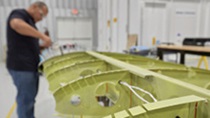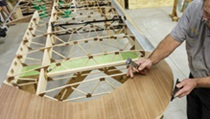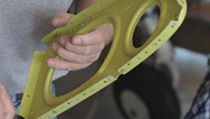What am I? Skeleton for your wing
Ribs are elemental to an aircraft’s wing structure

Most ribs extend chordwise from the leading edge of the wing to the rear spar, or to the trailing edge of the wing. The ribs give a wing its cambered shape, and they transmit loads from the skin and stringers to the spars. Spars, the wing’s primary structural members, and stringers run spanwise, from the center of the aircraft toward the wing tips.
Sheet metal or fabric wing skins attached to the ribs also play an important role, holding the wing’s proper aerodynamic shape. Skins also carry some of the flight loads and transfer those stresses to the wing ribs—which, in turn, transfer the loads to the wing spars.
A nose rib is a partial rib that extends only from the leading edge to the wing’s forward spar. A nose rib also might be called a false rib, a term for any rib that does not extend the full chord of the wing. Depending on the design, a nose rib could be installed between full ribs, for example, or in front of a fuel tank bay to support the leading edge and ensure it retains the proper shape.
A wing butt rib might be found at the inboard edge of the wing, where it attaches to the fuselage; ribs also may be called bulkheads or compression ribs depending on location or design.
Wing ribs normally are made from metal or wood. Aircraft with metal wing spars typically will have metal ribs, while aircraft with wood wing spars may have wood or metal ribs. Truss-type ribs frequently are the most efficient wooden ribs, because they are both strong and lightweight, but truss ribs also are the most complicated to build. Similar ribs will be found in ailerons, elevators, rudders, and stabilizers.






